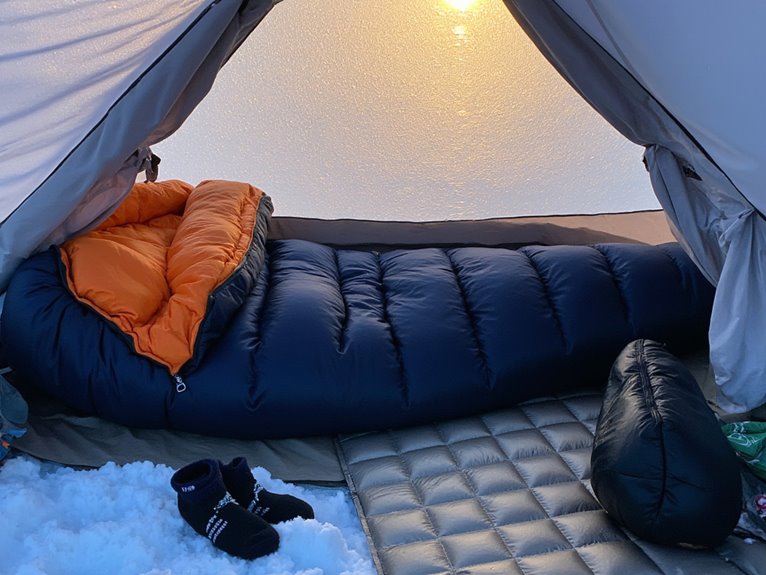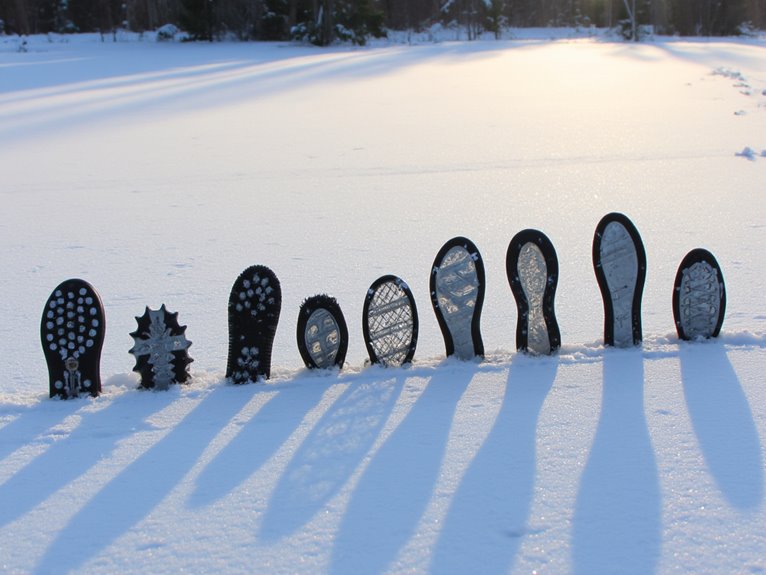Winter Sleep Systems: How to Sleep Warm Below Freezing
You’ll need a sleeping pad with an R-value of 5.0 or higher for adequate ground insulation, combined with a sleeping bag rated 25-30°F warmer than expected temperatures. Layer closed-cell foam pads with inflatable pads to maximize thermal protection. Warm up with light exercises before sleep, change into dry base layers, and consume warm beverages 30 minutes prior to bedtime. Keep your face outside the sleeping bag to prevent moisture buildup that reduces insulation effectiveness by 50%. These foundational strategies form just the beginning of extensive winter sleep system optimization.
We are supported by our audience. When you purchase through links on our site, we may earn an affiliate commission, at no extra cost for you. Learn more. Last update on 9th December 2025 / Images from Amazon Product Advertising API.
Notable Insights
- Use sleeping pads with R-values of 5.0 or higher, combining closed-cell foam with inflatable pads for maximum ground insulation.
- Choose sleeping bags rated 25-30°F below expected temperatures, prioritizing Comfort ratings over Limit ratings for reliable warmth.
- Warm your core body temperature before sleep with light exercises, hot beverages, and change into completely dry base layers.
- Create a modular layering system combining sleeping bag liners, fleece blankets, and hybrid insulation for temperature adaptability.
- Manage moisture by keeping your face outside the bag, maintaining tent ventilation, and storing wet clothing outside your sleep system.
Understanding R-Values and Insulated Sleeping Pads for Ground Protection
Ground insulation forms the foundation of any effective winter sleep system, with R-values serving as the critical measurement for determining a sleeping pad’s thermal resistance.
R-values are the cornerstone measurement for determining how well your sleeping pad protects against ground cold transfer.
R Value terminology represents a standardized scale ranging from 1 to 7, with higher numbers indicating superior resistance to heat transfer. Winter camping requires R-values of at least 5.0 for adequate ground protection.
Insulation effectiveness directly correlates with R-value ratings. Values between 4.0-5.4 suit cold weather conditions, while ratings of 5.5 and above handle extreme cold environments.
You can combine multiple pads to increase overall R-value by adding their individual ratings together. This stacking method creates enhanced thermal barriers against frozen ground surfaces, essential when temperatures drop below freezing and conductive heat loss becomes your primary thermal enemy.
Winter pads use heat-reflecting layers and specialized insulation to combat extreme conditions, providing the enhanced thermal protection necessary for sub-freezing temperatures.
Building Effective Insulation Systems That Retain Body Heat
While R-values provide the foundation for ground protection, you’ll need a thorough insulation system that addresses all forms of heat loss to maintain core body temperature throughout winter nights.
Your base layer starts with ground insulation. Combine closed-cell foam pads with inflatable pads for maximum thermal protection and puncture resistance. Place fleece or wool blankets between your tent floor and sleeping pad to trap additional heat.
| Layer Type | Primary Function | Best Application |
|---|---|---|
| Closed-cell foam | Consistent insulation | Primary ground barrier |
| Reflective mats | Reduce radiative loss | Elevated sleeping systems |
| Natural materials | Emergency warmth | Survival situations |
Add sleeping bag liners to increase warmth by 5-15°F without compressing insulation. Seal wind gaps around your tent with snow barriers. For winter camping, look for sleeping pads with R-values between 4.0-9.5 to ensure adequate insulation from frozen ground. Your insulation materials work together as a system—foam provides reliability while air pads offer comfort and reflective surfaces redirect body heat back toward you.
Creating Versatile Layered Sleep Configurations for Changing Conditions
You’ll need a strategic approach to building layered sleep configurations that can adapt to temperature swings throughout the night and across different seasons.
Modular systems let you add or remove insulation layers based on real-time conditions, while smart component selection guarantees each piece serves multiple purposes across various weather scenarios.
Cost-effective multi-use setups maximize your gear investment by combining sleeping bags, quilts, and liners into configurations that work from fall camping through sub-zero winter expeditions.
Hybrid insulation options provide an excellent foundation for these systems, combining the warmth-to-weight ratio of down with synthetic materials’ moisture resistance while retaining 80-90% loft in wet conditions.
Modular Component Selection Strategy
Anyone can master winter sleep system selection by understanding how modular components work together to create adaptable warmth configurations. Your core system includes three primary elements: a 3-pound patrol bag rated to 30°F, a 4-pound ICW bag rated to -10°F, and a waterproof bivy cover.
These modular bag configurations snap together via interface compatibility, allowing infinite temperature adaptability.
Choose your patrol bag solo for temperatures above 30°F. Deploy the ICW bag alone for conditions between 30°F and -10°F. Connect both bags for extreme cold below -10°F, achieving -30°F protection.
Always add the bivy in wet or windy conditions for moisture protection and additional insulation.
This systematic approach guarantees you’ll carry only necessary components while maintaining ideal warmth-to-weight ratios across varying winter conditions.
Seasonal Layer Adjustment Methods
Because winter conditions change rapidly, your sleep system must adapt through strategic layering adjustments rather than relying on single-piece solutions. Effective layering techniques allow you to add or remove components as temperatures fluctuate throughout the night.
| Layer Type | Cold Conditions | Moderate Conditions |
|---|---|---|
| Outer Layer | Synthetic shell + bivy | Breathable quilt only |
| Insulation | Down bag + synthetic liner | Down bag only |
| Pad System | Closed-cell + inflatable | Single inflatable pad |
| Base Layer | Merino wool + synthetic | Moisture-wicking synthetic |
| Accessories | Hand warmers + hood | Sleeping bag liner |
This modular approach enables comfort customization based on personal heat output and environmental factors. Synthetic insulation performs better in damp conditions, while down excels in dry cold. Stack sleeping pads to increase R-values when ground temperatures drop considerably.
Cost-Effective Multi-Use Systems
Smart layering strategies don’t require purchasing expensive single-purpose winter gear when you can build versatile multi-use systems from modular components. You’ll maximize gear utility by combining existing summer equipment with targeted upgrades that deliver multi-season performance.
Cost effective options for building modular sleep systems:
- Base insulation upgrade – Replace cheap foam pads with quality closed-cell mats like the Thermarest Z-Lite (R-value 2.5, ~$90 AUD) that also function as ground sheets and sit pads.
- Synthetic liner additions – Add 15°C warmth to existing quilts using removable liners for incremental temperature expansion.
- Quilt layering combinations – Combine 40°F and 20°F rated quilts to achieve -10°F comfort ratings without dedicated winter bags.
Multi use gear maximizes investment by serving multiple functions across seasons and conditions.
Interpreting Temperature Ratings and Optimizing Sleeping Bag Performance
When you’re selecting a sleeping bag for winter conditions, understanding temperature ratings becomes essential for avoiding cold, sleepless nights in the backcountry.
The ISO 13537 standard provides three key ratings: Comfort, Limit, and Extreme. The Comfort rating applies to a standard woman in relaxed posture without feeling cold. The Limit rating indicates the coldest temperature an average man can maintain thermal equilibrium while curled up.
Understanding ISO 13537 ratings helps you choose the right sleeping bag temperature rating for your body type and sleeping style.
Real-world bag performance differs considerably from lab conditions.
Variables like body metabolism, clothing layers, sleeping pad insulation, and wind affect actual warmth. If you sleep cold, rely primarily on the Comfort rating. Warm sleepers can use the Limit rating for lighter options.
For practical application, add 25-30°F to the manufacturer’s temperature ratings to determine your true comfort level in field conditions.
Optimize performance by layering clothing, using quality insulated pads, and ensuring proper bag fit.
Essential Pre-Sleep Preparation Techniques for Maximum Warmth
Your body’s core temperature naturally drops as evening approaches, but you can counteract this physiological cooling through targeted pre-sleep preparation techniques.
Warming up before bed involves generating internal heat through light exercise or consuming warm foods, while managing moisture and hydration requires balancing fluid intake with your body’s need to stay dry throughout the night.
These preparation methods work together to establish ideal thermal conditions before you enter your sleeping system.
Warming Up Before Bed
Before you slip into your sleeping bag, raising your core body temperature through deliberate preparation can mean the difference between a restful night and hours of shivering discomfort.
Your body’s internal furnace needs activation before entering cold conditions.
Three Essential Pre-Sleep Heat Generation Methods:
- Physical Movement: Execute 2-3 minutes of pre bed exercises including jumping jacks, squats, or arm circles to increase circulation by 15-20%.
- Strategic Nutrition: Consume 8-12 ounces of warm beverages like chamomile tea 30 minutes before sleep, avoiding caffeine which disrupts rest cycles.
- External Heat Sources: Deploy hot water bottles heated to 140°F or chemical hand warmers generating 8-hour heat output.
Change into dry base layers immediately after warming activities. This prevents evaporative cooling from moisture-laden clothing.
Managing Moisture and Hydration
Once you’ve activated your body’s heat production, moisture becomes your sleep system’s primary enemy.
Your body produces approximately one liter of moisture overnight through breathing and perspiration. This moisture creates condensation impact that compromises insulation effectiveness by up to 50%.
Keep your face outside the sleeping bag when breathing. Moisture from exhalation reduces down insulation’s loft and thermal performance.
Hang damp clothing outside your sleep system or place it between your sleeping pad and bag.
Effective hydration techniques require strategic timing. Drink water two hours before sleep, then minimize intake to reduce nighttime sweating.
Use moisture-wicking liners made from Coolmax or Tencel Lyocell.
Ventilate your shelter properly to prevent condensation buildup.
Turn your sleeping bag inside-out each morning, allowing trapped moisture to evaporate completely.
Budget-Friendly Gear Solutions for Cold Weather Camping

While quality winter camping gear can cost thousands of dollars, you don’t need to break the bank to stay warm and safe in cold conditions. Budget gear options deliver essential performance at accessible prices.
Start with synthetic insulation sleeping bags rated to -20°C for $100–$200. Pair these with foam sleeping pads offering R-values of 5 or higher.
Essential affordability tips include:
- Prioritize thermal rating over premium features when selecting sleeping bags.
- Choose synthetic insulation over down to reduce costs while maintaining warmth.
- Select basic 4-season tents starting at $200–$300 with sturdy pole systems.
Layer synthetic insulating clothing using Polarguard or Climashield materials. Invest in quality base layers, warm hats, and insulated gloves.
For extreme cold conditions, consider sleeping pads with R-values exceeding 8 or 9, like the INVOKER 3.15 or Wevelel Memory models, which provide superior ground insulation for freezing temperatures.
These strategic choices maximize warmth while minimizing expenses.
Moisture Management and Maintenance for Long-Term Gear Performance
Three critical moisture threats can destroy your winter sleep system’s performance within hours: internal condensation from body heat, external humidity infiltration, and accumulated perspiration that freezes and thaws repeatedly.
Effective moisture reduction techniques start with proper ventilation—keep tent vents open even in sub-zero conditions to maintain airflow. Change into dry base layers before entering your sleeping bag, removing any damp clothing that increases interior humidity.
Maintain tent ventilation in freezing temperatures and swap damp clothing for dry base layers before sleeping to control interior moisture buildup.
Damp gear management requires immediate attention. Hang wet items in cold, dry air rather than packing them compressed. Wipe down tent walls with microfiber cloths to prevent drip accumulation.
Position your sleeping area away from condensation zones where warm air meets cold surfaces. Store sleeping bags unrolled between uses to maintain loft and prevent mildew formation that degrades insulation performance.
Choose sleeping pads with higher R-values specifically designed for cold temperatures below 40°F to prevent ground heat loss that contributes to overall moisture accumulation in your sleep system.



